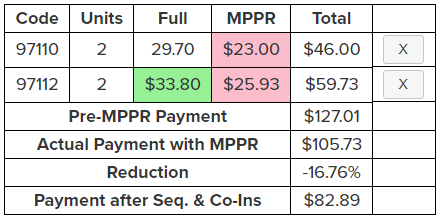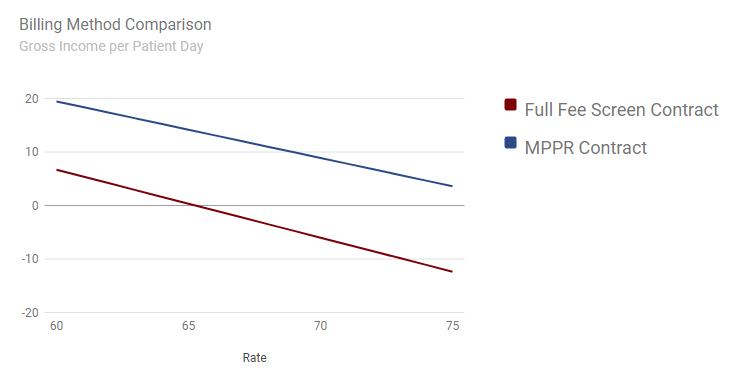We’ve just released an MPPR calculator that you can use to see how much difference MPPR makes to your Part B billing. The rest of this post is going to be about features and how to use the tool. If you’d prefer to get right to it, the calculator is here. You can also get to it by clicking the Calculators link at the top of the page.
First, start off by selecting the area of the US you’re in. The calculator supports all GCPI areas. You can change the area at any time to see the difference in reimbursement across the country.
The calculator works by allowing you to configure a “patient day”. That is, you select all the codes you would perform on a typical patient on a typical day.. The calculator will show you how MPPR changes the reimbursement.

Click the “Add Code” button to start adding codes for the day. Select the CPT code and the number of units you performed. (I didn’t add all CPT codes to make the tool more user friendly. If you have a code you absolutely need, contact me.)
As you add codes, the calculator will show you which codes will be paid full fee screen and which will be reduced and by how much. Click the small X in the far right column to remove a code. Click the “Add Code” button to continue adding codes. Click the reset button to… well you know.

In the example above you can see that we did 4 total units. Under the MPPR rules, only ONE code will be paid the full fee screen and the other three will be reduced by 50% of the PE portion of the code. (If you’d like information on just how that calculation is done, see this blog post.) The green box indicates which code will be paid full fee screen. Pink boxes indicate MPPR rates. In our example we did 2 units of 97112. One will be paid full fee screen and one is reduced so both boxes are highlighted.
The example shows that instead of the $127.01 total pre-MPPR, we’re down to $105.73 even before things like sequestration and coinsurance. The last line shows you what the actual remittance check will say.
Billing Comparison
Below that I included a billing comparison so you can see the difference between being billed by the full fee screen and the MPPR rates. You can select the percentages for each to compare.

Using our same example data you can see that if you were billed 70% of the full fee screen, the bill for therapy would exceed the remittance. In other words you’d be paying for Part B therapy out of pocket.
Billing by the MPPR guarantees there is some margin because you are billed off of what you actually receive instead of pre-MPPR fee screens. In this example you would keep $8.88 instead of paying an additional $6.02 for this day of therapy.
Lastly, I included a graph to compare the two billing methods. It’s useful to visualize what the rate would have to be to make full fee screen billing cash flow from your reimbursement. Note that the graph will change depending on which codes you select and the number of units you perform.

Understanding MPPR is important. Hopefully the new calculator will make things easier. Please don’t hesitate to contact me if you have questions or just want to talk about MPPR.
Until then, start exploring the MPPR!


